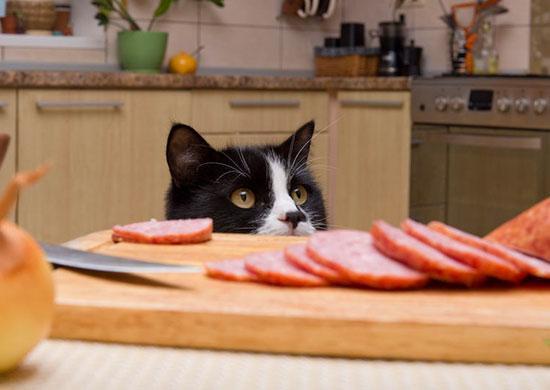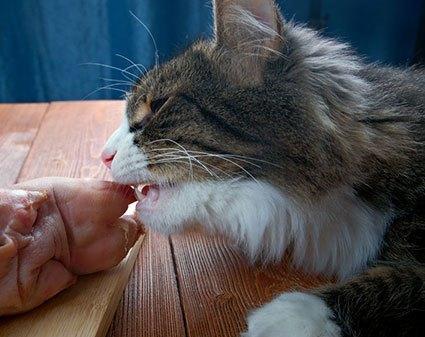This content is archived from the Feline Nutrition Foundation
Are Cats Clandestine Consumers?
- Updated: Saturday, June 01, 2019 02:43 PM
- Published: Saturday, May 09, 2015 08:02 PM
- Written by Margaret Gates
 I once met with a representative from a meat producer trade group. I thought they might be interested in Feline Nutrition's efforts to educate pet parents on feeding raw food for cats. I asked whether they had figures on the amounts or percentages of human-grade meat purchased for pets by consumers. The rep looked surprised, as if it had never occurred to her to ask this particular question. It turned out it was something they didn't track, period.
I once met with a representative from a meat producer trade group. I thought they might be interested in Feline Nutrition's efforts to educate pet parents on feeding raw food for cats. I asked whether they had figures on the amounts or percentages of human-grade meat purchased for pets by consumers. The rep looked surprised, as if it had never occurred to her to ask this particular question. It turned out it was something they didn't track, period.
Perhaps the industry rep wasn't surprised by the question, but only that someone was asking it. They may be aware this occurs, even if they don't track the figures. Maybe they don't want to track this particular aspect of consumption. There is likely a lot of meat going directly to pets. One trade publication lists the average amount eaten by a woman in the US as 4.5 ounces a day. Interestingly, that is the amount eaten by the average cat per day. For every cat that switches to a raw meat diet, it's like adding a new "human" consumer to the equation. For many households, it's the pets that consume most of the meat purchased. If they don't track who's actually eating it, their ideas about human meat consumption in this country may be significantly innaccurate.
I can look to my own household as a telling example. My husband and I are meat eaters, but we eat only poultry and a little fish. We have many meatless meals by personal preference. We purchase around 10 pounds of meat each month for ourselves. But for our raw-fed clowder, we buy about 90 pounds per month. Most pet parents wouldn't get this much, and we haven't considered raw-fed dogs, of which there are many. One large dog can eat more than all of my cats combined. Adding them to the equation could significantly skew the figures the industry uses.
 The rep was honest in saying they couldn't endorse the feeding of human-grade meat to pets. It wasn't that they were against it per se, but were concerned the producers they represented might not like it. They would worry the market for the non human-grade parts and leftovers would dry up. You know, that's all the stuff that goes to the pet food trade. That's a huge part of their business. If consumers suddenly wanted human-grade meats for their pets, well, that would be a problem for them. A big problem.
The rep was honest in saying they couldn't endorse the feeding of human-grade meat to pets. It wasn't that they were against it per se, but were concerned the producers they represented might not like it. They would worry the market for the non human-grade parts and leftovers would dry up. You know, that's all the stuff that goes to the pet food trade. That's a huge part of their business. If consumers suddenly wanted human-grade meats for their pets, well, that would be a problem for them. A big problem.
Of one thing I am certain. The movement to feed raw food to cats and dogs can have a positive impact on the industry. We may be the ones to force much needed change in how meat is raised and processed in this country. Ask the average person if raw meat is dangerous, and you will get a resounding yes. This idea that raw meat is something to be feared is firmly established in our collective consciousness. We've all heard the dire warnings about cooking it thoroughly for safety. What many people don't grasp is that meat itself isn't inherently dangerous. Fresh muscle meat from an animal is close to sterile. It becomes dangerous when contaminated from other sources. This unnecessary contamination results from contemporary practices by which animals are raised and slaughtered. The industry counts on its products being cooked, killing harmful bacteria before being consumed. It need not and should not be there in the first place.
Don't get me wrong. I don't think the meat industry is all bad. The US has some of the safest meat in the world. Much has been done to improve the situation. They are genuinely concerned with safety. We understand this is not an easy thing on this scale. But, as more and more consumers buy human-grade meat to feed their pets a raw diet, the demand for meat free of pathogens will increase. The industry will no longer be able to shift the solution of cooking to the consumer. Conditions and practices must eliminate the threat. HPP is just one idea. As with all products, when there is a consumer demand, the market will find a way to meet it. Although healthy adult cats are highly resistant to illness from ingesting small levels of most pathogens, unlike humans who are pretty wimpy in this respect, it's still something no one should have to worry about.
 As a group, those of us who feed natural, raw foods are intensely animal-focused. We provide our companion animals with a raw diet out of concern for their health and well-being. That isn't limited to our cats and dogs. We're more connected to the fact that our furry friends are eating other animals than the folks who dish out the kibble. It's inescapable when you deal with raw animal parts on a daily basis. You can't look at your cat's dinner of chicken hearts and liver and pretend another animal hasn't died to feed her. We get that. We don't want those animals to have suffered or been mistreated for the sake of our own. As we grow in numbers and become a larger portion of meat-buying consumers, we can demand meat animals be treated more humanely. Simply by shifting our purchases to more humanely-raised meats, we influence the industry.
As a group, those of us who feed natural, raw foods are intensely animal-focused. We provide our companion animals with a raw diet out of concern for their health and well-being. That isn't limited to our cats and dogs. We're more connected to the fact that our furry friends are eating other animals than the folks who dish out the kibble. It's inescapable when you deal with raw animal parts on a daily basis. You can't look at your cat's dinner of chicken hearts and liver and pretend another animal hasn't died to feed her. We get that. We don't want those animals to have suffered or been mistreated for the sake of our own. As we grow in numbers and become a larger portion of meat-buying consumers, we can demand meat animals be treated more humanely. Simply by shifting our purchases to more humanely-raised meats, we influence the industry.
Something else that goes hand in hand with better practices for meat safety is better quality. When we feed raw cat food, we become intensely interested in its nutrient profile. The meat with the best nutritional makeup comes from animals raised under better and more natural conditions. Interestingly, many people start questioning the nutritional value of meat once they feed it to their pets. Often, they don't seek out that information when only eating it themselves.
Additional Reading
Answers: Are Exotic Meats Nutritious or a Novelty for Cats?
Answers: What Exactly is an 'Obligate Carnivore?'
There are new opportunities for the industry as a reflection of this change. Almost all chicken hearts from the US poultry industry are exported, despite being an excellent and sought-after part of raw food for cats. Poultry growers have no use for male chicks, often grinding them up for feed. They would make an excellent food for cats if sold whole. Rabbit is another great food for cats, but is not widely grown in the US. As more pet parents change how they feed their cats and dogs, it will be a positive influence on the entire industry, whether they welcome it or not.
Margaret Gates is the founder of the Feline Nutrition Foundation.




